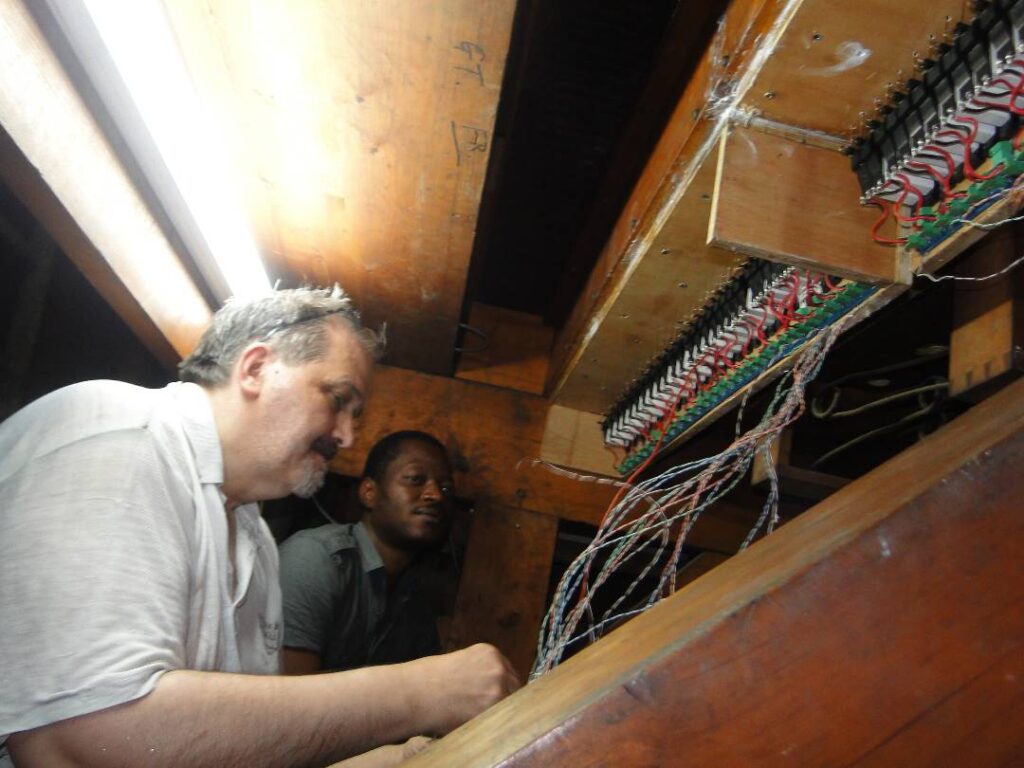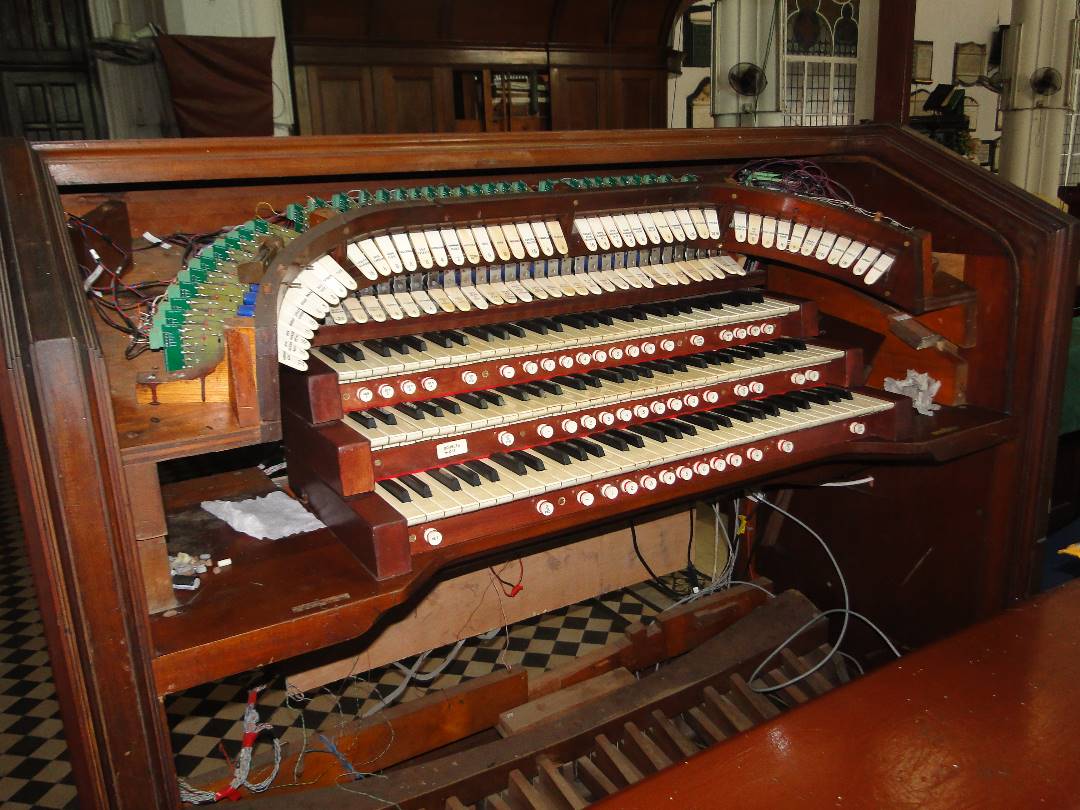
Why is the church investing so much in renovating the pipe organ? Why is it so important to the church?
The Cathedral is investing in restoring the Pipe Organ because it is the greatest asset after the edifice (the building) and an important part in the enhancement of music in praise and worship to God, our Creator in the Cathedral.
Why not replace the pipe organ with an electronic organ instead of rehabilitating and restoring the pipe organ?
Digital organs are a viable alternative for churches that may have a pipe organ and can no longer afford to maintain it. In the United Kingdom, the high initial cost, and longer lead time to design, build, and “voice” pipe organs has limited the production of pipe organs. Another reason that all-digital and pipe/digital hybrid organs now significantly outsell pipe organs is the dwindling number of pipe organ dealers. Many churches are hundreds of miles from dealers capable of selling, installing and servicing pipe organs. The situation is different in the United States of America where “the Pipe Industry has entered the 21st century as a vibrant, active, and busy industry with industry sales totaling close to $70 million annually.”
In addition to building new pipe organs, rebuilding older instruments is an important part of the industry’s activities. Often a rebuild, which gives a church a virtually new instrument, can be accomplished for a fraction of the cost of a totally new instrument. In a typical year about 100 major rebuilds of pipe organs are completed in the U.S. and Canada. In addition, each year many instruments have sets of pipes added and/or upgrading of the console and minor refurbishing completed.
In Freetown, the pendulum has swung from the installation by W&O Pipe Organs of refurbished second-hand pipe organs in the decade starting 2000 (Wesley Church, Christchurch, Saint Phillips, Warren, Holy Trinity etc), to the installation of digital church organs in the decade starting 2010 (Buxton, Samaria, Saint John, Bethel, Jehovah Shammah, Judea etc).
Canterbury Cathedral: Canterbury Cathedral is a typical recent case study. In this case the decision was made to rehabilitate and expand the existing organ as opposed to purchasing and installing a new digital church pipe organ. In early 2017, Regent Classic Organs visited Canterbury Cathedral to discuss the provision of a temporary Digital Organ during the two-year period whilst the Pipe organ was being rebuilt. This was part of a tender process for the temporary organ service. Regent Classic was successful in the bid and have installed the temporary Digital organ. This was a custom-built organ which involved significant engineering design and installation challenges.
What is the added value of the pipe organ to Saint Georges Cathedral?
Looking at our situation it is worth considering the question of value. Value often refers to monetary worth. Indeed, even an aging pipe organ in disrepair is often the single largest asset of a church. However, good stewardship regarding a pipe organ requires thinking of all aspects of value – the monetary value and the quality of sound value.
Monetary Value: the Cathedral Organ has a replacement cost of $825,000. This is an asset worth preserving by any stretch of the imagination. To place matters in perspective the organ of the Cathedral Church of Christ, Diocese of Lagos, Marina, a 64 stop, 4 manual pipe organ cost close to $1 million when installed in 2010. The rehabilitation and upgrade costs for the Canterbury Cathedral organ is $5.5 million.
The monetary worth of a pipe organ is easier to quantify than that of an electronic organ. The pipes of an organ rarely lose their value. With few exceptions, pipes can be revoiced after decades of use for a fraction of their original cost or the cost of new pipes. Similarly, the chests, console, casework, and structural elements of a pipe organ retain their value. Like antique furniture, a well-maintained pipe organ can appreciate in monetary value as it ages. This makes rebuilding an aging pipe organ desirable because it allows the church to preserve an asset with relatively less financial outlay than replacing it.
Sound Value: The pipe organ is better than the electronic organ for sacred church and choral music and also organ recitals in the Cathedral. It has a round melodious sound and when played by an experienced, trained and qualified organist when accompanying the choir gives an additional part to the blend as a 5th part of the Choir. The blend is something out of this world.
Life span: The life span of a pipe organ is more than a century and when properly maintained will last for centuries. Most of the pipe organs in Europe are over 200 years old and still in perfect working order. Electronic organs can last up to 30 years maximum when properly maintained. In Sierra Leone because of weather and electricity problems no electronic organ has lasted for 20 years in any church, whereas all churches which have pipe organs have had them for over 80 or more years. What we need in Sierra Leone is a company for organ repairs and servicing and this will be set up in the very near future.
Architecture: The architectural design of the Cathedral is for a pipe organ because of its height, area, and air passage. Electronic organs have also been used in the past for special performances by choral groups in the Cathedral and the sound quality is blaring and hollow which is a total contrast of sound quality even to the “Old Lady Pipe Organ” which was built in the 19th Century and upgraded in the first decade of the 20th Century. This organ is presently in use as work is being done on the new one.
You will never ever compare the sweet sound of the organ under restoration to any electronic one in Sierra Leone. This is a matter that is receiving increasing attention. I believe the current majority view is that the pipe organ performance is “more thrilling” or has “more fullness of sound”. Also experimentation in large cathedrals, where enormous amounts of air have to be moved, has proved that pipes can project their tone much farther than electronic speakers.
Someone has said that listening to a pipe organ can be compared to listening to a live orchestra whilst listening to a digital or electronic organ can be compared to listening to a CD.
Financial Analysis
Assumptions: The approach adopted is a life cycle cost approach based on the following assumptions:
Rehabilitation/Restoration of Existing Organ: This is assumed to be done by organ repairer Jonathan Lane with local support. The repair is estimated to cost $140,000. However, this work involves major restoration work which will increase the value of the restored organ to about $1 million.
Major Maintenance and Tuning: It is assumed that an Organ Repair Company is set up and registered in Sierra Leone for pipe organs with Jonathan Lane & Associates Limited being shareholders. It is also assumed that major maintenance will be done every 50 years by this company at a cost of $30,000
First 5 Years Maintenance and Tuning Visit: This is done every year by the local company for the first 5 years with annual visits by Jonathan Lane for a cost of $15,000. Practical training would be provided by Mr. Lane during these visits.
Annual Maintenance and Tuning ($): This is done by the local team at a cost of $2,000
Cost of a Digital Organ Suitable for the Cathedral: The cost estimate is $100,000.
The costs of recent digital organs installed in Freetown were:
Buxton: $58,500
St Patricks: $40,000
The Cathedral is much larger than Buxton and St. Patrick. This means that much greater amounts of air will have to be moved with consequent impact on the cost of the digital organ.
Replacement period for digital organs: The replacement period of 30 years is provided in the article by David Mason Owner of Viscount Organs (electronic organs) on Weighing Up the Costs Pipe or Digital Organs.
Annual maintenance costs: An annual maintenance cost of $1,000 is estimated
Life cycle cost: The estimated life cycle costs assuming a 150 year period are shown below:
Rehabilitation/Restoration of Existing Organ: $565,000
Digital Organ: $750,000
This analysis which does not consider the time value of money, indicates that the option to rehabilitate/restore the organ has lower life cycle costs.
Peterson Electro-Musical Products, Inc. in an article “The Sound of Pipes – Why is it Better?” wrote that “If a church has a pipe organ, it is generally better to repair or renovate it, as necessary, and preserve it, as opposed to replacing it with an electronic or digital organ.” The analysis of the life cycle cost of the Cathedral organ appears to support Peterson-Electro-Musical Products.
What place do you think pipe organs have in worship in Africa?
The pipe organ continues to be the King of musical instruments for it is known to have all the sound components of musical creativity. Other musical instruments do find a place in worship or the other classical or choral performances, but the pipe organ ranks the top most place with pride above all others.
On a personal note I must say that the organ in its present state is not a joy to play. One now plays it with trepidation because you can never know what part of the organ is going to malfunction. This can range from what is called cyphering which is what happens when you suddenly hear a note sounding when you have neither drawn a stop or played the note to all the stops in a manual disengaging without you touching them.









